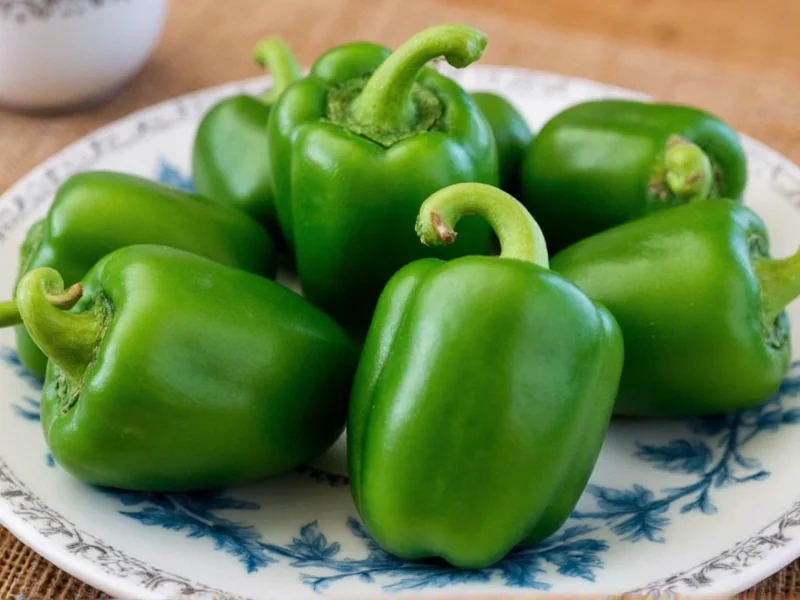Many home cooks and recipe enthusiasts encounter confusion when distinguishing between chile poblano and chile pasilla. Understanding the difference between these peppers is essential for authentic Mexican cooking and proper ingredient substitution. Despite frequent misuse of these terms, poblano and pasilla peppers are distinct varieties with different characteristics, flavor profiles, and culinary applications.
Understanding the Poblano Pepper
Chile poblano (Capsicum annuum) is a large, heart-shaped pepper typically harvested while still green and fresh. Measuring 4-6 inches long and 2-3 inches wide, it features thick walls and a mild to medium heat level ranging from 1,000 to 2,000 Scoville Heat Units (SHU). When roasted and peeled, poblano peppers develop a rich, earthy flavor with subtle notes of grass and bell pepper.
When dried, the poblano transforms into what's known as an ancho pepper, not pasilla. This critical distinction explains much of the confusion surrounding these terms. Ancho peppers develop a sweeter, fruitier flavor profile with hints of raisin and tobacco, making them ideal for mole sauces and other complex Mexican dishes.
Understanding the Pasilla Pepper
True chile pasilla (also Capsicum annuum) refers specifically to the dried form of the chilaca pepper, not the poblano. The fresh chilaca pepper is long (6-8 inches), narrow, and dark green to black in color. When dried, it becomes the pasilla, characterized by its wrinkled, dark brown to black appearance and raisin-like aroma.
Pasilla peppers register between 1,000-2,500 SHU, placing them in the mild to medium heat range. Their flavor profile features earthy, smoky notes with subtle hints of berries and licorice. In Mexican cuisine, pasilla is often called the "workhorse" of dried peppers due to its versatility in sauces, stews, and moles.
Why the Confusion Exists
The poblano/pasilla confusion primarily stems from regional naming differences. In some parts of Mexico and among certain communities, dried poblanos are incorrectly called "pasillas." However, according to Mexican culinary tradition and agricultural standards, this is inaccurate.
Adding to the complexity, "pasilla" literally translates to "little raisin" in Spanish, describing the appearance of the dried chilaca pepper. Meanwhile, "poblano" refers to Puebla, the Mexican state where these peppers originated. Understanding these etymological roots helps clarify the proper identification of each pepper.
| Characteristic | Chile Poblano (Fresh) | Chile Pasilla (Dried Chilaca) |
|---|---|---|
| Origin Name | Puebla, Mexico | "Little raisin" (appearance) |
| Shape | Heart-shaped, wide | Long, narrow, wrinkled |
| Size | 4-6" long, 2-3" wide | 6-8" long, 1-1.5" wide |
| Color (Fresh) | Dark green | Dark green to black |
| Color (Dried) | Becomes ancho (reddish-brown) | Dark brown to black |
| Heat Level | 1,000-2,000 SHU | 1,000-2,500 SHU |
| Flavor Profile | Earthy, grassy, mild bell pepper | Smoky, earthy, raisin, licorice |
| Common Uses | Chiles rellenos, fresh salsas | Moles, adobo sauces, stews |
Substitution Guidance
When a recipe calls for chile pasilla and you only have poblanos (or vice versa), understanding appropriate substitutions is crucial. For fresh poblano, acceptable substitutes include Anaheim or cubanelle peppers. For dried pasilla, the best alternatives are mulato or ancho peppers, though each brings slightly different flavor notes.
Never substitute fresh poblano for dried pasilla directly—this would dramatically alter your dish's texture and flavor profile. If using fresh peppers in place of dried, you'll need to adjust quantities significantly (typically 3-4 fresh peppers for every 1 dried pepper) and account for the additional moisture content.
Culinary Applications
Chile poblano shines in dishes where its thick walls can hold fillings, such as traditional chiles rellenos. Its mild heat makes it perfect for stuffed peppers, fresh salsas, and as a roasted vegetable component in various Mexican dishes. When dried as ancho, it becomes essential for authentic mole poblano and other complex sauces.
Chile pasilla, with its distinctive earthy-sweet profile, forms the backbone of many Mexican mole varieties, particularly mole negro. It's also commonly used in adobo sauces, salsas de molcajete, and as a flavor enhancer in braised meats. The dried form typically requires rehydration before use, either by soaking in hot water or toasting then simmering in liquid.
Shopping Tips
When purchasing fresh poblano peppers, look for firm, glossy skins without wrinkles or soft spots. They should feel heavy for their size. For dried pasilla peppers, select those with deep, rich color and avoid any with excessive cracks or signs of mold. Properly stored dried peppers should maintain their flavor for 6-12 months in an airtight container away from light.
Understanding the difference between poblano and pasilla peppers prevents recipe failures and helps maintain authenticity in Mexican cooking. Remember: fresh poblano becomes ancho when dried, while pasilla is always the dried form of chilaca. This knowledge empowers you to make informed ingredient choices and substitutions that honor traditional culinary techniques.











 浙公网安备
33010002000092号
浙公网安备
33010002000092号 浙B2-20120091-4
浙B2-20120091-4